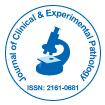Advances in Scarless Wound Healing
Received: 06-Aug-2014 / Accepted Date: 01-Sep-2014 / Published Date: 04-Sep-2014 DOI: 10.4172/2161-0681.1000191
310132Commentary
Wound care is a perennial burden for the US healthcare system, costing an estimated $25 billion annually for the treatment of chronic wounds alone [1]. Problems surrounding scarring have also created a $12 billion market annually for treatment [2]. In the 1979 landmark study, Rowlatt et al. reported that human fetal wound healing did not cause scar formation [3]. Animal models were subsequently developed which better defined this phenomenon [4]. Understanding the regenerative repair mechanisms will promote clinical applications to achieve the “holy grail”: to recapitulate scarless wound healing.
Adult wound repair is characterized by a quick fibro proliferative response, designed to minimize exposure to infection and further injury. However, drawbacks such as the formation of a thick, poorly organized collagen bundle, lack of hair follicles and sebaceous glands, and a flattened epidermis with rete ridges results [5,6]. Anomalies in this fibro proliferative response can induce pathologic scars, such as hypertrophic scars or keloids, which can cause pain, itching, pediatric growth restriction, and, in severe cases, morbidity and death [7].
Additionally, scarring can lead to psychosocial ramifications when they occur in highly visible areas such as the face. On the other hand, scarless fetal wounds are characterized by full dermal and epithelial tissue recovery, complete with epidermal appendages such as hair follicles and sebaceous glands, and a reformed collagen pattern identical to the pre-wound state. In addition, the inflammatory response of fetal wounds features the lowered presence of neutrophils, macrophages, and mast cells, and also lowered expression of inflammatory cytokines such as TGF-ß1, TGF-ß2, interleukins, and VEGF [8,9].
Also, the extracellular matrix (ECM), a network of adhesion proteins, proteoglycans, and glycosaminoglycans (GAGs), controls critical features that distinguish adult wound repair from fetal wound regeneration. In fetal scarless regeneration, wound matrix proteins are deposited more rapidly, with a higher ratio of type III to I collagen, and higher levels of hyaluronic acid (HA) and fibromodulin, but decreased crosslinking of collagen, and lack of decorin [8].
Although we have yet to achieve scarless repair in adults, there are current developments paving the path to attain this elusive goal. Tissue engineering utilizes biomaterials, such as fibrin, HA, and collagen, to construct scaffolding similar to the fetal ECM for therapeutic cell delivery, wound support, and direction for improved tissue regeneration8. Additionally, off-loading devices have been shown to mitigate scar formation by mimicking the reduced tension environment present in the fetal wound [10].
Recent findings have implicated mesenchymal stem cells (MSCs) in promoting accelerated wound closure and enhanced repair, sparking more attention and research into the role of stem cells during fetal wound healing [11]. And more recently, adipose-derived stem cells (ASCs) have garnered increasing attention because they can be easily harvested in abundance via less invasive procedures, such as liposuction [12]. These studies have already translated to clinical research/applications. Such developments offer hope that the “holy grail” will someday be uncovered.
Acknowledgement
This work was supported in part by CIRM Clinical Fellow Training Grant TG2-01159 (to M.S.H.), CIRM Creativity Award (to T.N.Z.), NIH Grant R01 GM087609 (to H.P.L.), a Gift from Ingrid Lai and Bill Shu in honor of Anthony Shu (to H.P.L.), and the Hagey Laboratory for Pediatric Regenerative Medicine and Children's Surgical Research Program (to M.T.L. and H.P.L.).
References
Citation: Hu MS, Zhu TN, Walmsley GG, Longaker MT, Lorenz HP (2014) In Search of the “Holy Grail”: Advances in Scarless Wound Healing. J Clin Exp Pathol 4:191. DOI: 10.4172/2161-0681.1000191
Copyright: © 2014 Hu MS, et al. This is an open-access article distributed under the terms of the Creative Commons Attribution License, which permits unrestricted use,distribution, and reproduction in any medium, provided the original author and source are credited.
Share This Article
Recommended Journals
Open 91جزة« Journals
Article Tools
Article Usage
- Total views: 15308
- [From(publication date): 11-2014 - May 04, 2025]
- Breakdown by view type
- HTML page views: 10662
- PDF downloads: 4646
